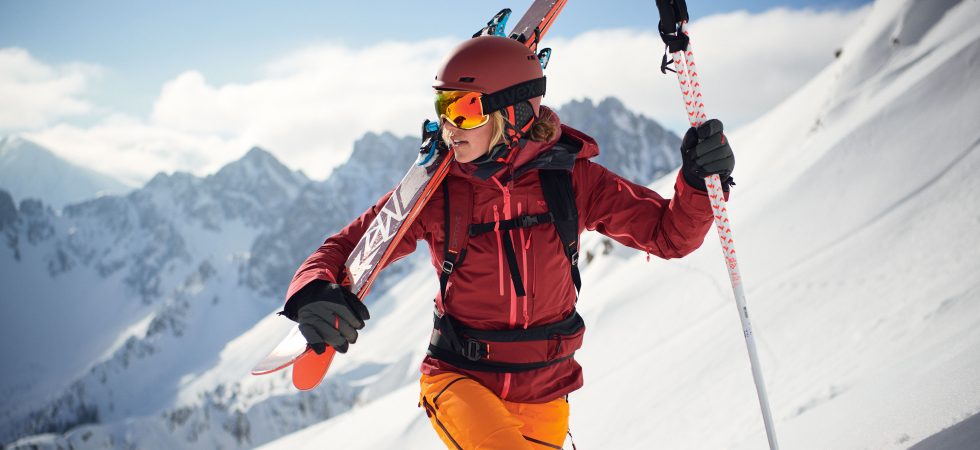Ski goggles should fit snugly and comfortably, with no gaps between the goggles and your face. Ski goggles are an essential piece of equipment for anyone hitting the slopes.
They not only protect your eyes from the harsh winter elements but also enhance your visibility in varying light conditions. However, finding the right fit for your ski goggles is crucial for both comfort and safety. Goggles that are too tight can cause discomfort and hinder circulation, while loose-fitting goggles may allow cold air or snow to enter and impair your vision.
To ensure a proper fit, the goggles should sit snugly against your face, with no gaps around the edges. Additionally, the strap should be tight enough to keep the goggles in place without applying excessive pressure. Finding the perfect fit will enhance your skiing experience and allow you to fully enjoy your time on the slopes.
Table of Contents
ToggleImportance Of A Perfect Fit
Ski goggles should fit perfectly to ensure clear vision and protection on the slopes. A snug and comfortable fit prevents them from moving or fogging up, allowing skiers to fully enjoy their winter adventures.
Protecting Your Eyes On The Slopes
When it comes to skiing, protection should be your top priority. And one area that often gets overlooked is eye protection. While wearing ski goggles is essential, it is equally important to ensure they fit perfectly. The right fit not only provides maximum protection for your eyes but also enhances your overall skiing experience.
Preventing Fogging And Discomfort
Poorly fitting ski goggles can lead to fogging and discomfort, which can be highly frustrating while you’re on the slopes. When goggles don’t fit snugly, they allow warm air from your face to circulate inside, causing condensation and fogging. This obstructs your vision and can hamper your performance on the slopes. A perfect fit, on the other hand, creates a seal that prevents warm air from entering, ensuring clear vision throughout your ride.
Enhancing Your Overall Skiing Experience
Wearing ski goggles that fit perfectly can make a world of difference to your skiing experience. When your goggles fit well, they stay in place even during swift movements, providing stability and preventing distractions. This allows you to focus on the thrill of skiing without constantly adjusting or worrying about your eyewear. Having the right fit also ensures proper ventilation, preventing excessive sweating and discomfort. It allows for optimal airflow, keeping your face cool and preventing excessive moisture build-up. With comfortable goggles, you can fully enjoy the adrenaline rush of skiing without any distractions or irritations. Investing in ski goggles that fit perfectly is crucial for your safety, comfort, and enjoyment. Keep these points in mind while choosing your next pair of ski goggles, and embrace the slopes with confidence!
Understanding Your Face Shape
When it comes to choosing the right ski goggles, understanding your face shape is key. The fit of your goggles not only affects your comfort but also impacts your performance on the slopes. Each face shape has its own unique characteristics, and it’s essential to consider these when selecting your ski goggles.
Different Face Shapes And Their Characteristics
1. Oval Face:
An oval face is considered the ideal shape for goggles. It has balanced proportions with gently rounded features and a slightly narrower forehead and jawline. With an oval-shaped face, you have the advantage of being able to pull off a variety of goggle styles.
2. Round Face:
If you have a round face, your cheekbones and face width are nearly equal. The goal with goggles is to elongate your face visually, so opt for goggles with a more rectangular or squared shape. This will create the illusion of length to complement your facial structure.
3. Square Face:
A square face is characterized by a strong jawline and a wide forehead. Ski goggles with softer lines and rounded edges can help soften the angular features of a square-shaped face. Look for goggles that follow the natural contours of your face to achieve a balanced look.
4. Heart-Shaped Face:
Heart-shaped faces are wider at the forehead and taper towards the chin. The key with goggles for this face shape is to find pairs that add width to the lower part of the face. Look for frames that have a wider bottom or feature curves that start lower on the sides to balance out your facial proportions.
5. Long or Narrow Face:
If you have a long or narrow face shape, choose goggles with a larger frame size to add width to your face and create a more balanced appearance. Avoid narrow or small goggles as they can make your face appear even longer.
How Face Shape Affects Goggle Fit
Now that you know your face shape and its characteristics, it’s important to understand how it affects the fit of your ski goggles. Different face shapes require goggles with specific frame designs and sizes to ensure a proper fit and optimal performance.
Your face shape affects where the goggles sit on your face, the coverage they provide, and their compatibility with your helmet. Ill-fitting goggles can result in discomfort, interference with your peripheral vision, or even compromise their ability to protect your eyes from the elements.
Tips For Determining Your Face Shape
Determining your face shape is crucial for selecting the right ski goggles. Here are a few tips to help you figure out your face shape:
- Start by pulling your hair back and looking in the mirror.
- Examine your face’s proportions and observe the width of your forehead, cheeks, and jawline.
- Measure the length and width of your face using a tape measure or ruler.
- Compare your measurements with the characteristics of different face shapes.
- You can also seek assistance from an experienced optician or try online face shape analysis tools for additional guidance.
Once you’ve determined your face shape, you can confidently choose ski goggles that will not only fit snugly but also enhance your appearance and overall performance on the slopes.
Key Factors For A Perfect Fit
When it comes to ski goggles, a perfect fit is essential for both comfort and performance. Ski goggles that fit well not only provide clear vision and better protection but also enhance your overall skiing experience. Whether you are an experienced skier or a beginner, understanding the key factors for a perfect fit is crucial. In this article, we will discuss three essential aspects you should consider when choosing ski goggles: proper bridge fit and comfort, snugness around the temples and cheeks, and adequate coverage and peripheral vision.
Proper Bridge Fit And Comfort
The bridge of your nose plays a significant role in determining the comfort and fit of your ski goggles. For a proper bridge fit, make sure the goggles sit comfortably on the bridge of your nose without exerting excessive pressure. To achieve this, pay attention to the following:
- Adjustable nose bridges: Opt for ski goggles with adjustable nose bridges as they allow you to customize the fit according to your nose shape and size.
- Soft foam padding: Look for goggles with soft foam paddings around the nose area. This not only enhances comfort but also helps create a better seal and prevents cold air or snow from entering.
- No gaps: When properly fitted, the goggles should not leave any gaps between the nose and the frame. This ensures a secure and comfortable fit, minimizing the risk of fogging and maintaining clear vision throughout your skiing session.
Snugness Around The Temples And Cheeks
In addition to the bridge fit, it is essential to ensure that your ski goggles fit snugly around your temples and cheeks. A proper fit in these areas helps to improve stability and prevents the goggles from shifting or slipping during high-speed skiing or challenging terrains. Follow these guidelines for a snug fit:
- Adjustable straps: Look for goggles with adjustable straps to achieve a personalized fit around your temples and cheeks. This enables you to tighten or loosen the strap according to your preference.
- Firm grip: The goggles should have a firm grip on your temples and cheeks without causing discomfort or pressure points. This ensures that the goggles stay in place and do not obstruct your vision while skiing.
- No gaps or slippage: When properly fitted, the goggles should not leave any gaps between your face and the frame. Moreover, they should not slide down or shift during your ski runs.
Adequate Coverage And Peripheral Vision
While the fit around your nose, temples, and cheeks is crucial, it is equally important to consider the coverage and peripheral vision offered by the ski goggles. Here are some factors to keep in mind:
- Frame size: Select goggles with an appropriate frame size that provides ample coverage for your eyes and the surrounding areas. The frame should extend beyond your eyes to shield them from wind, snow, and debris.
- Wide field of view: Look for goggles with a wide field of view that allows for excellent peripheral vision. This enables you to see your surroundings more clearly, enhancing your safety and overall experience on the slopes.
- Helmet compatibility: If you wear a ski helmet, make sure the goggles fit comfortably with the helmet. They should seamlessly integrate with the helmet’s shape and not create any gaps or discomfort.
In conclusion, achieving a perfect fit for your ski goggles is essential for a comfortable and enjoyable skiing experience. Take the time to consider these key factors, such as proper bridge fit and comfort, snugness around the temples and cheeks, and adequate coverage and peripheral vision. By selecting goggles that adhere to these factors, you will be able to ski with confidence, clarity, and unobstructed vision.
Choosing The Right Size
When it comes to ski goggles, one of the most important factors to consider is finding the right size. Wearing goggles that don’t fit properly can lead to discomfort, hinder your field of vision, and impact your overall skiing experience. To ensure a snug and comfortable fit, there are a few key considerations you should keep in mind.
Measuring Your Face For Goggles
Before you dive into the wide range of ski goggles available, it’s essential to measure your face to determine the right fit. Measuring your face not only helps you find goggles that are the correct width, but it also allows you to choose a pair that properly fits the distance between your eyes and nose.
| Measurement | How to Measure |
|---|---|
| Width | Place a tape measure at the temple area, across the bridge of your nose, and to the other temple area. This will give you an accurate measurement of your face width. |
| Nose Bridge | Measure the distance between your eyes at the bridge of your nose. This measurement is crucial as it determines how well the goggles will fit against your face. |
By measuring your face, you will have a clear indication of the ideal size range for your goggles. This allows you to narrow down your options and make a more informed choice when selecting the perfect fit.
Sizing Guide For Different Brands
It’s important to note that different brands may have varying sizing guidelines for ski goggles. While one brand’s medium might fit perfectly, another brand’s medium could be too large or too small. To ensure you choose the right size for different brands, it’s recommended to refer to their specific sizing guides.
These guides can typically be found on the brand’s website or product packaging. They provide valuable information regarding the measurements and proportions associated with each size. By consulting these guides, you can match your facial measurements to the brand’s guidelines and increase the chances of finding the perfect fit for your ski goggles.
Lens Size Considerations For Optimal Fit
In addition to the overall size of the goggles, it’s important to consider the lens size for an optimal fit. The lens size affects not only the coverage of your eyes but also how well the goggles fit against your face. Here are a few key factors to consider:
- Peripheral Vision: Opt for a lens size that provides adequate peripheral vision, allowing you to see clearly from your peripheral vision as you navigate down the slopes.
- Goggle Compatibility: Consider the compatibility of the lens size with the goggle frame. Different goggles may have specific lens sizes that fit more securely and comfortably within the frame.
- Helmet Integration: If you wear a helmet while skiing, ensure that the lens size doesn’t obstruct the fit or positioning of your helmet.
By considering these factors and choosing the right lens size, you can ensure that your goggles fit optimally, providing both comfort and functionality during your skiing adventures.
Adjusting Straps And Padding
Ski goggles should fit snugly, with adjustable straps and padding to ensure comfort and a secure fit during winter sports activities. Adjusting the straps and padding is crucial for proper positioning and preventing any gaps that could let in cold air or snow.
Introduction: Adjusting Straps And Padding
When it comes to finding the perfect fit for your ski goggles, adjusting the straps and padding plays a crucial role. The right tension in the straps ensures a secure fit, preventing the goggles from slipping while you glide down the slopes. In addition, properly positioned foam padding provides cushioning and a comfortable feel against your face. In this article, we will explore the importance of strap tension for a secure fit and the proper positioning of foam padding to ensure optimal comfort during your skiing adventures.
Importance Of Strap Tension For A Secure Fit
Proper strap tension is essential for your ski goggles to stay securely in place and provide unobstructed vision. When the straps are too loose, the goggles may shift or even fall off during fast-paced descents. On the other hand, overly tight straps can cause discomfort and create unnecessary pressure points on your face. To find the balance, follow these steps:
- Start by putting on the goggles and adjusting them to fit snugly against your face.
- Gently tighten the straps until you feel a secure hold without any excessive pressure.
- Make sure the straps are adjusted evenly on both sides to maintain symmetry.
- Double-check the fit by moving your head side to side and up and down to ensure the goggles stay in position.
Ensuring Equal Pressure Distribution
One aspect often overlooked when adjusting ski goggles is ensuring equal pressure distribution around your face. Uneven pressure can lead to discomfort, sore spots, and even headaches after extended use on the slopes. To achieve equal pressure distribution, follow these guidelines:
- Adjust the straps so that the pressure is evenly distributed on your forehead, cheeks, and the bridge of your nose.
- Inspect the foam padding to ensure it is flush against your face, creating a seal that prevents cold air and snow from entering.
- If you notice any areas where the pressure is uneven, adjust the straps or foam padding accordingly.
Proper Positioning Of Foam Padding
Achieving the perfect fit for your ski goggles also involves proper positioning of the foam padding. Well-positioned foam padding enhances comfort and prevents irritation during prolonged use on the slopes. Follow these steps for proper foam padding positioning:
- Place the goggles on your face and adjust the straps to hold them in position.
- Check that the foam padding is evenly distributed and rests comfortably against your face without any significant gaps or pressure points.
- Ensure the foam padding covers your entire eye area to create a snug fit that blocks out cold air and snow.
- If necessary, adjust the straps or foam padding until you achieve the desired fit and optimal comfort level.
By paying attention to the correct positioning of the foam padding, you’ll enjoy a secure fit that keeps your face protected from the elements while skiing. Remember, investing time in adjusting the straps and padding ensures your ski goggles fit perfectly – allowing you to concentrate on carving your way down the mountainside with clear vision and unmatched comfort.

Credit: www.sportrx.com
Frequently Asked Questions
How Should Ski Goggles Fit?
The ski goggles should fit snugly but not too tight. They should create a seal around your face to prevent cold air and snow from getting in.
Can Ski Goggles Be Too Big?
Yes, ski goggles can be too big. If they are too large, they may not provide a proper seal, allowing cold air and snow to enter.
Should Ski Goggles Touch Your Face?
Yes, ski goggles should touch your face to create a seal and prevent any gaps for cold air or snow to get in.
How Tight Should Ski Goggles Be?
Ski goggles should be snug and secure but not too tight. They should be comfortable and allow for easy movement of your head.
Can Ski Goggles Be Too Small?
Yes, ski goggles can be too small. If they are too small, they may not cover your eyes adequately, leaving them exposed to wind and snow.
Conclusion
Finding the right fit for your ski goggles is essential for comfort and safety on the slopes. Properly fitting goggles ensure a snug yet comfortable feel, while also providing a wide field of vision. Remember to adjust the strap properly and consider different shapes and sizes to find the perfect fit for your face.
By following these tips, you can fully enjoy your skiing experience with goggles that fit just right. Happy skiing!
You may also like to read this – Do You Need Ski Pants to Ski?






